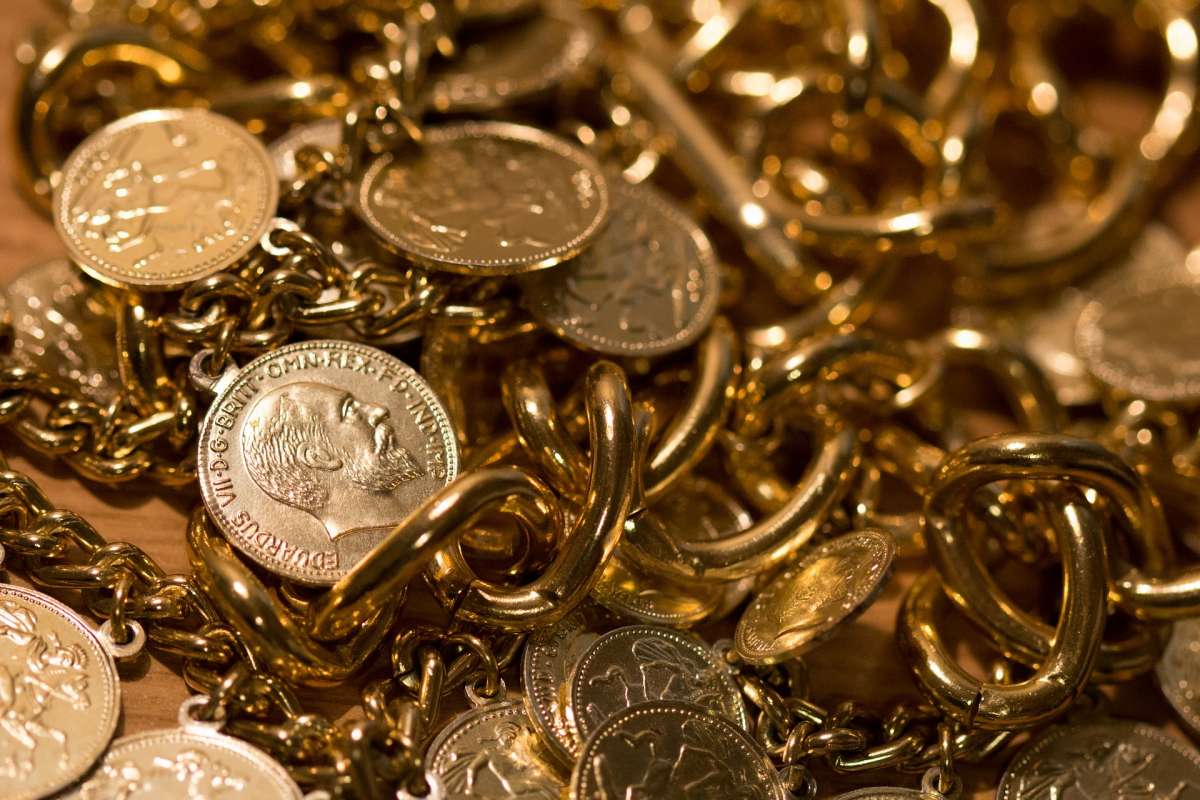
A set of 200-year-old ciphers may reveal the location of millions of dollars’ worth of gold, silver, and jewels buried in rural Virginia. For the past century, the quest to break these codes has attracted the military, computer scientists, and conspiracy theorists. All have failed. Which raises the question: Are the ciphers and the treasure even real?
The medium gazed into the crystal ball and looked deeply into the past. The year was 1898, and the room in which he sat was dimly lit. But inside the mysterious orb, the year was 1819, and the scene was about to become blindingly bright.
The medium claimed he could see into the upper bedroom of Paschal Buford’s tavern, an old watering hole below the Blue Ridge Mountains near modern Montvale, Virginia. The room was dark. Shades blanketed the windows and a wad of paper was plugged into the door’s keyhole. Inside, a lone frontiersman named Thomas J. Beale eyed a pair of saddlebags resting on the bed.

Gently, he opened them. Light burst through the room. The medium shielded his eyes and shrieked.
“Jewels, by gosh! Diamonds! Rubies! Pearls! Emeralds!!”
Inside the crystal ball, Beale stared at the gems, smiled, and gingerly tucked the saddlebags under a pillow. The light receded.
Back in 1898, Clayton Hart watched the medium with jittery anticipation. Clayton’s brother George, a skeptic, stood nearby in silence. The two were trying to gather potentially life-changing information: Seventy-nine years earlier, Thomas Beale had reportedly buried millions of dollars of riches in the foothills near Montvale. The readings were the Hart brothers’ last-ditch effort to divine its location.

Lucky for them, the medium claimed to see the pioneer’s every move: Beale had arrived at Buford’s tavern on horseback with a rifle resting on his lap, a pair of pistols on each hip, and two jewel-filled bags slung from his saddle. Five covered wagons followed him, some hauling iron pots of gold and silver. After resting at Buford’s, Beale and his men buried that gold, silver, and jewels deep in the Virginia woods, approximately four miles from the tavern.
As the medium described its location, Clayton clung to every syllable.
Months later, under the cover of nightfall, Clayton and George steered a buggy full of shovels, ropes, and lanterns into Montvale. Joining them—reluctantly—was their trusty medium. Clayton hypnotized the mystic, who led the brothers up Goose Creek, over a fence, and across a burbling stream to a slumped depression in the earth.
The medium pointed to the dirt. “There’s the treasure!” he said. “Can’t you see it?”
Guided by lanterns and moonbeams, the Hart brothers dug. Hours passed. The hole deepened and the sky reddened. As daybreak loomed, tendrils of morning fog began to roll between the ridges. Clayton Hart thrust his pick into the red, iron-rich dirt and heard a hollow thud.

The brothers exchanged glances. Clayton dug frantically. When a large rock emerged, the brothers excitedly flipped it over. Nothing was below it.
The medium (who had refused to help all night, opting instead to lounge on a bed of dead leaves) was re-hypnotized and told to explain himself. He pointed to the roots of an oak tree just feet away and exclaimed: “There it is! You got over too far! Can’t you see it?”
The Hart brothers, exhausted and annoyed, left.
One week later, Clayton returned to that same spot with dynamite. The sky rained dirt, pebbles, and the splintered remains of that old oak tree—but no gold.
These events, described in a pamphlet written by George in 1964 [PDF], convinced the Hart brothers that mesmerism was not the path to fortune. If they wanted to discover Thomas J. Beale’s buried treasure, they’d have to search like everybody else: By solving a puzzle.
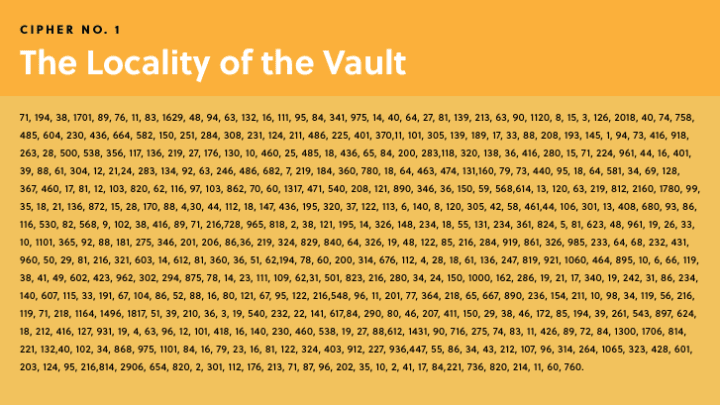
If the numbers above mean anything to you, congratulations: 2921 pounds of gold, 5100 pounds of silver, and $1.5 million of precious jewels—together valued at approximately $60 million—are yours for the taking, because you just cracked a cipher purported to reveal the location of the treasure Thomas J. Beale buried nearly 200 years ago.
The backstory of Beale’s treasure has been re-hashed countless times: Beale was a 19th century adventurer who supposedly discovered gold and silver on a hunting trip near the modern New Mexico-Colorado border. He lugged the riches home to Virginia and buried them, reportedly concealing the details—the location, contents, and heirs of the treasure—in three separate ciphers. So far, only one of those codes, Cipher No. 2, which describes the contents of the treasure, has been decrypted.
The codes are basic substitution ciphers. Each number represents a letter of the alphabet, which can be found by numbering the words in a “key” text. (Take the cipher [87 118]. If the key text is Mary Roach’s book Stiff, just number each word in her book. The 87th word starts with “h.” The 118th word starts with “i.” Therefore, the code spells “hi.”)
As long as a key is available, a substitution cipher is a safe, simple way to encrypt a message. The trouble with Thomas J. Beale’s ciphers, however, is that we don’t have the keys.
For the past two centuries, attempts to solve the Beale codes have been a guessing game. In the late 19th century, an anonymous amateur cryptanalyst stumbled on the key to Beale’s second cipher—the Declaration of Independence—and revealed this opening sentence:
I have deposited in the county of Bedford, about four miles from Buford’s, in an excavation or vault, six feet below the surface of the ground …
The message describes the treasure in detail and ends with this maddening sweetener: “Paper number one describes the exact locality of the vault so that no difficulty will be had in finding it.”
So far, it’s been nothing but difficulty.
Amateur and professional cryptanalysts have desperately searched for the lost key texts, consulting the Louisiana Purchase, Shakespeare’s plays, the Magna Carta, the Monroe Doctrine, the United States Constitution, “The Star-Spangled Banner,” the Lord’s Prayer, the Songs of Solomon, the Book of Psalms, old local newspapers, and even the thrilling text of the Molasses Act of 1733. “Cryptanalysts say a second-grader could break the ciphers if he lucked in on the documents on which they are based,” journalist Ruth Daniloff writes [PDF]. Until that happens, the other two ciphers will remain an unintelligible jumble of numbers.
That’s a problem. Like all good riddles, the Beale codes have an addictive quality that curious people can’t resist. But unlike most riddles, solving them could make you a millionaire. Because of those stakes, the codes have the potential to consume—and ruin—people’s lives.
They come with metal detectors and magnetometers, Geiger counters and dowsing rods, backhoes and pickaxes, psychic mediums on speed dial and sticks of dynamite stuffed into their back pockets. They come motivated by a quirky Virginia state law that says buried treasure is finder’s-keepers (even if it’s discovered on private property). They come gripped by a monomaniacal belief that they—and only they—know where Beale’s treasure hides: the foothills, a farm, a cave, a grave, a cistern, a creek, an abandoned road. One treasure hunter insists it’s buried at a local visitors’ center, right under the ladies room.
For these treasure hunters, a survey of the past 70 years of newspaper headlines shows a bleak pattern:
MAN HOT ON THE TRAIL OF THOMAS BEALE’S TREASURE. FOLLOW-UP: MAN WRONG.
There’s the Chicago refrigeration contractor, certain he had broken the ciphers in five days, who convinced local officials to dig up a graveless patch of a cemetery, only to find clothes hangers (metal) and horseshoes (unlucky). There’s the Texas man who drove to Virginia, wife and kids in tow, simply to borrow a local roadmap that he believed would lead to the treasure. (It didn’t.) There’s the Massachusetts man who jumped out of bed, jolted by a dream, and drove bleary-eyed toward the Blue Ridge Mountains to test his prophecy. There’s the Oklahoma psychic who surveyed the Goose Creek Valley from a helicopter. There’s the Virginia Supreme Court Justice who scouted the location by bicycle; the Washington state man who hired armed guards; the anonymous man who kept an armored truck idling on a nearby road.
Beale treasure hunters are overwhelmingly male, though locals still chatter about one Pennsylvania woman, Marilyn Parsons, who cashed a disability check in 1983 and rented a backhoe to test her theory that the treasure was buried in an unmarked plot of a church graveyard. When she unearthed a coffin handle and human bones, she was arrested and advised to never step foot in Virginia again.
Like the Hart brothers, many treasure hunters trespass under starlight. In 1972, The Washington Post reported that local landowners regularly fired warning shots at strangers tip-toeing on their property. “People would sneak onto their land and blow big holes out of the ground and leave them that way. Cows would step in and break their legs,” Ed Easterling, a local Beale expert, says. “Most people here have resented it.”
The federal government owns swaths of land near Montvale—the Blue Ridge Parkway and Appalachian Trail weave through the peaks near town—and it doesn’t take kindly to unpermitted treasure-digging either. In the early 1990s, a Pennsylvania church group tore up the Jefferson National Forest on federal holidays, believing they’d elude the fingerwagging of rangers if they worked on the government’s day off. (They were caught and forced to re-fill the pits.)
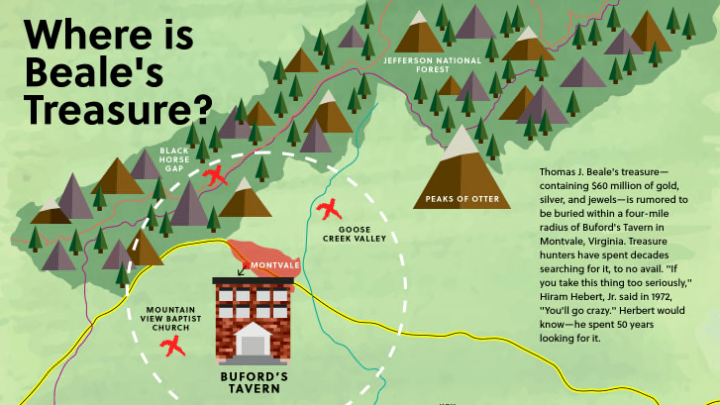
Even those considerate enough to ask for permission are treated with hesitation, says Danny Johnson, a local farmer and winery owner. “A guy will sign a contract, saying he’ll put the land back in shape after digging. Then they go broke and leave! Then the landowner has to go and put their land back.”
A lot of treasure hunters, Johnson mentions, appear to go broke.
The guy who cracked the second Beale cipher is among them. Upon breaking the code, the anonymous cryptanalyst rode a wave of adrenaline that, according to one 19th century author, compelled him “to neglect family, friends, and all legitimate pursuits for what has proved, so far, the veriest illusion.” Peter Viemeister, a Bedford-based author who wrote the book The Beale Treasure: A History of a Mystery, said, “Once you get the Beale treasure in your system, it is hard to get it out. You could get possessed by it. Like drugs or gambling, it can lead a vulnerable person to stake everything on a dream.”
Families have crumbled, bank accounts have evaporated, and jobs have disappeared. One man, Stan Czanowski, spent $70,000 over seven years on dynamite and bulldozers. In the early ’80s, one treasure hunter bankrupted himself after blasting rocks for six months. (He abandoned town still owing the local motel money.) An editor at the American Cryptograph Association spent so much time focused on the ciphers that he was fired. The researcher Richard Greaves, who investigated the Beale story for decades, called it “possibly the worst decision I ever made. If I would have devoted all the hours spent pursuing this treasure legend to the study of medicine, I would easily have become an accomplished neurosurgeon.”
Which makes it all the more painful to consider that Beale’s treasure—the ciphers, the story, the gold, the silver, and the jewels, even Thomas J. Beale himself—might all be a big, fat hoax.
In April 1817, Thomas J. Beale and a party of about 30 men reportedly left Virginia and moseyed west with the goal of hunting buffalo, grizzlies, and other critters frolicking in the wild frontier. When Beale’s party reached Santa Fe—then Spain’s domain—his crew split up and aimed for what is now the Colorado border. There, in a ravine, they discovered gold and silver. Over the following year, they mined thousands of pounds of precious metal.
The bonanza kept Beale looking over his shoulder. He knew his men were in hostile territory and eventually “decided that it should be sent to Virginia under my charge, and securely buried in a cave near Buford’s tavern, in the county of Bedford,” he wrote.
A mule train plodded east to St. Louis, where Beale exchanged some ore for jewels. When he arrived in Virginia, he buried the haul not in a cave as intended, but in a grave-sized plot about four miles from Buford’s tavern.
Beale would repeat that trip once more before returning west for good in 1821. Prior to his final journey, he lodged at the Washington Hotel in Lynchburg, Virginia and befriended the hotel’s owner, Robert Morriss. As the story goes, before leaving, Beale handed Morriss a iron lockbox and advised him to open the box if he failed to return. Morriss didn’t know it, but that box contained the three ciphers.
That detail isn’t as fanciful as it may sound. Exchanging secret messages was common in the early 19th century—many men, especially veterans of the Revolutionary War and the War of 1812, had basic ciphering skills—and it’s likely that Beale and Morriss knew something about secret codes. But Beale never sent a key. And after 10 years, he failed to return.
Morriss would spend nearly two decades attempting to unravel the codes. In 1862, a year before his death, he handed the materials to an anonymous acquaintance who lucked onto the Declaration of Independence as a key. In 1885, that unknown man enlisted the help of James B. Ward to publish a pamphlet telling Beale’s story. In 1885, “The Beale Papers” was published as a thin blue booklet. The price was $0.50.
It has created controversy ever since.
If that whole story sounds fishy, that’s because it is.
To start, the story of Beale’s trip west overflows with damning anachronisms. If history books are to be believed, Beale’s men found gold more than 30 years before precious metals were discovered in that region. Furthermore, there are no records documenting a party of Beale’s size—one that almost certainly would have been arrested for trespassing on foreign soil—going west.
There are also problems with the ciphers. As Dr. Todd Mateer of the N.S.A. notes in a 2013 paper for the journal Cryptologia, if you decrypt Cipher No. 2 with the original Declaration of Independence, you don’t get:
I have deposited in the county of Bedford about four miles from Buford’s …
You get:
A haie deposoted tn ttt eointt oa itdstrrs aboap thrr miles troa baaotts …
Beale’s letters are suspicious, too. In 1982, the linguist Dr. Jean Pival compared Beale’s prose to the writing of the pamphlet’s anonymous author and found that both used reflexive pronouns incorrectly, copied the prosody of the King James Bible, and overused negative passive constructions such as never to be realized and never be told. “The striking similarities in the Ward and Beale documents argue that one author was responsible for both,” Pival wrote. Further scrutiny by the myth investigator Joe Nickell showed that Beale’s letters contained words such as stampeding and improvised, terms Beale never would have used—because they did not exist when he wrote the letters.
This evidence (and much more) has convinced most casual observers that the treasure story, the codes, and even the character of Thomas J. Beale are part of a canard designed to sell pamphlets. In other words, the reason nobody has found Beale’s treasure is because there is no treasure to find.
Beale enthusiasts refuse to accept this. In fact, when they first encountered these anachronisms, few dropped their shovels or chucked their maps; rather they picked up books and dove into special archives rooms to start a new hunt—a search to find counter-evidence in the historical record that would pile doubt on the doubters. It’s here, in this madcap search for a factual knockout punch, that doing research on the Beale treasure story can become just as addicting as searching for the treasure itself. Because when you don’t find what you’re looking for, you might keep looking … and keep looking … and keep looking … until you can no longer afford to stop.
Jennifer Thomson drops a stack of nine books on my table at the Bedford County Museum and Genealogical Library with a thud. “That’s everything we have on Beale,” the resident genealogical librarian tells me. She recedes to a back room, and I begin leafing through the books—only to be startled by a sudden plop.
A 9-inch stack of manila folders stuffed with papers has materialized on my desk. “Oh, sorry,” Thomson says. “And these.”
She repeats this back-and-forth dance three more times. “And these … Oh, and these … Ahhh, yes! And finally—these.”
On this last assault, she sympathetically places the folders on the table, smirks, and whispers: “Have fun!”
I look down. I can no longer see the desk.
The materials held at the Bedford Genealogical library near Montvale, Virginia are a mixed bag of serious historical research and total crackpottery: There are copies of ancient maps, genealogies of people related to the treasure story, unpublished academic papers, handwritten letters, manifestos alleging the National Forest Service is engaged in conspiracy, “solutions” to the ciphers, and tortured sketches that evoke A Beautiful Mind. It would take weeks to consult it all.

Some people wave off Beale-ievers as nutters, but, looking at these materials, I think that’s lazy. People with legitimate talent have done legitimate work on the mystery. One of the top Beale experts, Dr. Stephen M. Matyas, was a skeptical IBM cryptanalyst with dozens of digital security patents. (He wrote a 700-plus page two-part book; one section was entitled The Hoax Theory Deflated.) Another Beale investigator, Victor Theyer, was a professional writer with proven research skills: He once found a missing woman who had been AWOL for nearly five decades. Dr. Albert C. Leighton, a professor of cryptology history, was a Fulbright Research Scholar who cracked a cipher linked to Pope Gregory XIII that had baffled codebreakers since 1573.
“Some of these people who come in here digging for it, heck no, I wouldn’t call them nuts,” Bedford County’s sheriff told The Ledger-Star in 1989. Thomson agrees. “There are people who want to solve the historical part of it—just to see if it’s accurate—and most of them are good, normal people just trying to solve a mystery.”
Many of these researchers believe the inconsistencies can be explained away. The archival research they’ve done to achieve this aim is, in some cases, hard to deny.
Take the criticism that silver and gold hadn’t been discovered yet. The specifics, they point out, are blurry. Beale researchers have dredged up old reports showing rumors of precious ore swirling decades earlier, with small traces of gold possibly being discovered before Beale’s trip.
The lack of evidence that Beale went west? Carl Nelson Jr., an ex-C.I.A. agent, combed through old newspapers from St. Louis—what would have been Beale’s last checkpoint before the frontier—and discovered a postmaster’s notice in an October 1817 copy of The Missouri Gazette for an “S. T. Beall” and an 1820 notice for a “Thomas Beall” in The Franklin Intelligencer. As for Beale’s ability to avoid arrest, researchers point to the Adams-Onis treaty of 1819, which redrew the border between the United States and what was called “New Spain.”
The rebuttal to the clunky cipher solution is impressive. Stephen Matyas researched this discrepancy and compiled one of the world’s most complete collections of Declaration of Independence copies. From 1776 to 1825, the Declaration appeared in more than 350 publications, each of which made slight alterations to the text: Unalienable over inalienable, mean time over meantime, institute a new government over institute new government. A single extra word or space, Matyas argued, can corrupt a decipherment. Choose the wrong version and your solution will resemble alphabet soup.
As for the consistent language and the linguistic anachronisms in the pamphlet? That’s nothing, researchers say. Have you ever heard of an editor?
Some of their most remarkable work is genealogical. Researchers discovered that there was not one, but at least two Thomas Beales living within 20 miles of Montvale, Virginia during the early 19th century—and there’s a curious wrinkle in their stories. In the early 1800s, one of them dueled a Lynchburg, Virginia man named James Risque. Afterward, Beale reportedly fled town. Risque, who suffered a nonfatal gunshot wound to the gut, would stay and raise a family that included a grandson named James B. Ward; the same James B. Ward who would later help publish “The Beale Papers.”
What this all means is anybody’s guess. Not every crumb of information passes the courtroom test, though each discovery has undoubtedly helped Beale-ievers deflect criticism—and has encouraged an ecosystem of theories to bloom.
Indulge here in a small sample platter:
It’s a hoax perpetrated by James B. Ward! (Ward’s children denied this. His daughter “believed the story as she believed the Bible,” reported the Lynchburg News in 1934.) No, it’s a Freemason plot! (Beale hunter Brian Ford argued that it’s a “brilliantly-crafted Masonic allegory that teaches its moral, not just by stating it but by having the reader pursue or be tempted to pursue an illusion.”) The treasure is real … but was dug up decades ago! (“We know that in the late 1800s people were working in the Montvale area doing construction, and the next thing you know: They’re rich!” Thomson tells me.) The federal government found the treasure! (“[I]t has long since been removed by an N.S.A. task force disguised as U.S. Forest Service workers,” treasure hunter Frederick W. Chesson wrote.) It’s all a cover-up! (The treasure was stolen from the Confederate Treasury and it’s now hidden in—wait for it—Jerry Falwell’s attic!)
The list goes on. For people like Nick Pelling, a British computer programmer who runs the website Cipher Mysteries, the speculation makes his eyes roll. “I don’t think anything in it corresponds to historical fact,” he says of the Beale story. “Discussions about the Beale have lost a lot of focus, lapsed into argumentation based on the minutiae of the pamphlet.”
Pelling belongs to the third species of Beale hunter. In his view, the endless bickering over the story’s historical authenticity distracts from the true mystery: the codes. The real treasure isn’t what’s buried underground, but what’s buried in the numbers.
That’s been the opinion of cryptanalysts for nearly a century. In the 1930s, William F. Friedman, leader of the U.S. Army Signal Intelligence Service, or S.I.S.—the forerunner to the N.S.A.—spent his leisure hours attempting to untangle the Beale codes. He took them so seriously that his legal counselor drafted an agreement in case he solved them.
He never did, of course. In a letter, Friedman wrote: “So far as my attempts to produce an authentic reading is concerned, I can most earnestly say I have tried to the best of my ability and now must confess myself beaten.”
But Friedman never quit. Instead, he included the ciphers in the S.I.S training program. According to Frank Rowlett, an S.I.S. cryptologist who helped crack Japan’s PURPLE cipher machine during World War II, the trainees concluded the ciphers were phony. Friedman’s wife Elizebeth, also an accomplished cryptanalyst, dubbed them as a lost cause with a “diabolical ingenuity specifically designed to lure the unwary reader …. In fruitless research … or searching for a key book.” Friedman himself shrugged: “On Mondays, Wednesdays, and Fridays, I think it is real,” he said. “On Tuesdays, Thursdays, and Saturdays, I think it is a hoax.” (Sunday, it appears, was a day of rest.)
Other cryptologists of the era approached the ciphers with similar ambivalence. Herbert O. Yardley, whose 1931 tell-all book The American Black Chamber revealed the workings of America’s cryptography units, believed the Beale ciphers could be solved—but also admitted they looked “a bit fishey.”
That attitude would reign among professional cryptanalysts until January 1970, when Dr. Carl Hammer, Director of Computer Sciences at Sperry-Univac, made a startling revelation at the Third Annual Simulation Symposium in Tampa, Florida. He had analyzed the Beale ciphers with a UNIVAC 1108 computer and compared the codes to the musings of a random number generator. The results showed signs of an intelligent pattern.
“Beale Cyphers 1 and 3 are ‘for real,’” Hammer concluded. “They are not random doodles but do contain intelligence and messages of some sort. Further attempts at decoding are indeed warranted.”
At Fort Meade, Maryland, a few hundred yards from the barbed wire fences surrounding N.S.A. headquarters, the National Cryptologic Museum library holds a printout of Hammer’s computer analyses from 1965 [PDF]. It’s an unassuming, carefully folded stack of perforated paper. If you stood at the window of an eight story building and unfurled it, the scroll would tickle the sidewalk. Its only distinguished feature is a stream of faded, indecipherable text:
Hammer’s discovery, buried in a potpourri of text like this, reignited professional interest in the Beale ciphers. In 1969, an organization he kickstarted—later called the Beale Cipher Association, or B.C.A.—hosted a symposium in Washington, D.C. in an attempt to pool the best minds to tackle it.
Well, some of the best. Approximately 70 people showed up. The club attracted big names in the intelligence community such as Carl Nelson Jr., who had helped the C.I.A. intercept communist signals in a secret tunnel under Berlin; big names in data processing such as Per Holst, the Chief of Research at Massachusetts Foxboro Laboratories; and big names in government, including a U.S. District Judge and the Governor of Minnesota.
It also attracted people who, to put it kindly, had vivid imaginations.
With the aroma of Sanka wafting through hotel conference rooms, the B.C.A. symposiums presented a delicate balance of serious academic theories and New Age hocus pocus. Presenters raved about confusion matrices, 10×10 Hogg-Hugerman networks, and the application of neural networks to computer algorithms. Other presentations included a talk on inductive geodetic reasoning—a fancy way of saying, “If I hid treasure, where would I bury it?”—and a lecture on how to improve your dowsing rod accuracy. (One tip: Hug a tree.)
Over the following decade, the B.C.A. grew to boast more than 200 members from places as close as Michigan and as far as Holland. It hosted three more symposiums and published a quarterly newsletter, both of which presented sober scholarship and half-baked whataboutism.
Hammer, for his part, cared little for the treasure story. He saw the Beale ciphers as a cryptologic puzzle that could advance the field of computer programming. “I think it is fair to say that this effort has engaged at least 10 percent of the best cryptanalytic minds in the country, and represents much more than the value of the treasure even if it should be just as described,” Hammer told The Washington Post in 1979. “And not a dime of it should be begrudged; the work—even the lines that have led into blind alleys—has more than paid for itself in advancing and refining computer research.”
But for those who still cared about the treasure, the B.C.A. was a vital place to foster community. Beale researchers have always been a solitary, if not paranoid, bunch. They share a passion but rarely share detailed insights or leads with each other. “Why give away secrets only to find that someone else has found the treasure using your information?” Stephen Matyas once said. The consequence of keeping these ideas private, however, has turned the decoding process into a time-sucking vortex, with hundreds of researchers wasting hours as they test possibilities somebody else already ruled out. The B.C.A. was an organized attempt to overcome this atmosphere of distrust and streamline the search.
That said, most people’s “solutions” made Thomas J. Beale sound like a hepcat who had been couchsurfing at a bad beat poetry club.
Then, in 1980, James Gillogly, a computer scientist at the think tank RAND and the president of the American Cryptogram Association, discovered an even stranger message in the first Beale cipher—just not the kind the B.C.A. was hoping for.
The alphabet never looked so depressing. If you decode Beale’s first cipher with some versions of the Declaration of Independence, as James Gillogly tried in 1980, you’ll get gobbledygook—with the exception of this pseudo-alphabetical string in the middle of the code. Gillogly published his discovery in a Cryptologia essay called “A Dissenting Opinion” and calculated the chance it could occur randomly was 1 in 10,000,000,000,000.
Gillogly offered two interpretations: that the message is buried under a second level of encryption; or that this measly string of text was the intelligent pattern Hammer’s computer had detected. That is, the codes are almost certainly a hoax.
“I visualize the encryptor selecting numbers more or less at random, but occasionally growing bored and picking entries from the numbered Declaration of Independence in front of him, in several cases choosing numbers with an alphabetical sequence,” Gillogly wrote. In other words, a prankster was practicing his ABCs.
For the B.C.A., the news was deflating. Hammer could not deny Gillogly’s discovery but disagreed with his conclusion. It didn’t matter. Over the coming decade, enthusiasm at the B.C.A. waned. “Jim Gillogly’s article basically says ‘Give up,’” Pelling says. “And when one of the most respected historical codebreakers in the world says, ‘Pffft, don’t even try,’ a lot of codebreakers will say, ‘You know, I trust Jim on this one.’”
By 1999, the Beale Cipher Association had dissolved. Today, many of its members are dead. Any centralized attempt to decode the Beale ciphers has faded with them.
Pelling is one of the few who insists there is still work to be done. Like Carl Hammer, he believes the “Gillogly string” is a sign that something lurks in the message, a code beneath the code. “The presence of a pattern is presence of a signal,” Pelling says. “The Gillogly strings are evidence that there is something going on. The level of improbability is so high that this is not a freak chance … It’s just that the solution is one step sideways, and we don’t know where that step is.”
But computers might.
There are hundreds of supercomputers in the United States. At the Oak Ridge National Laboratory in Tennessee, the supercomputer Titan has a memory of 693 tebibytes and is capable of running at a speed of 27 petaflops, or approximately 27,000 trillion calculations per second. Which begs the eternal question: Shouldn’t computers have solved this sucker by now?
“I get this all the time,” Pelling says. “For Every. Single. Cipher.”
Computers aren’t magic. To decode a cipher, a human must write a program that can break it—and that means a human must understand how that individual cipher ticks. This becomes especially difficult when a code contains typos (the Beales certainly do) or requires a two- or three-step process (the Beales certainly might). “The computer is not the answer,” Hammer said at a Beale Cipher Association Symposium in 1979. “Even if it does all the work, we still have to find the type of work for it to do.”
To do that, a programmer has to grapple with two basic cryptologic concepts.
First, repetition. It’s easier to crack a cipher if the code contains repeated symbols. The short cipher [16 43 97 64] is impossible to crack without a key because it could signify nearly any four letter word. Now compare that to [16 43 43 16]. The repetition narrows our options. The code is clearly a palindrome—it could signify Anna, or Otto, or Elle, or deed, or peep, or poop, or sees, or noon, and so on. The problem is, without added context, we can never be sure which answer is correct. This problem is called unicity distance: When a cipher is too short, we might find multiple solutions.
These two principles are what convinced the great William F. Friedman to give up on the Beale ciphers decades ago: “I saw no hope at all of solving a cipher text so short and with so few repetitions of even single numbers,” he wrote. The first Beale cipher is 520 characters long and contains a whopping 299 unique symbols—an impossibly low rate of 1.74 repetitions per character. Friedman lamented: “[T]he application of scientific principles is impossible.”

That, of course, hasn’t stopped cryptanalysts from assaulting the Beale ciphers with every vocabulary word you can find in a cryptology textbook: higher-order homophony, super-encipherment via a keyphrase, Chi-square values calculated on a vector, concatenation, 2-gram statistical analyses, visible outer cipher and hidden inner cipher, beam search approaches.
In 2014, this last method was used by a Ph.D. student named Malte Nuhn and two fellow researchers at Germany’s Aachen University. They were developing an algorithm intended to improve the accuracy of machine translations, and they occasionally tested the strength of their program by feeding it ciphers such as the Zodiac-408 and the Beale Cipher No. 2.
The Zodiac-408 cipher, created by the eponymous serial killer in 1969, is the easiest of the four Zodiac codes. It’s 408 characters long and contains 54 unique symbols. Originally, it took one week to solve. Nuhn’s program, however, solved it in three seconds [PDF].
Meanwhile, the Beale Cipher No. 2—the longest and most repetitious of the Beale ciphers—took eight CPUs roughly 30 hours of work. The program muscled the correct solution with just 5 percent error. It was the first time a computer had automatically deciphered a Beale cipher without any reference to the key.
For fun, Nuhn and his colleagues fed the program the two unsolved Beale ciphers, which contain far less repetition and are much shorter. Nothing intelligible appeared.
“Maybe the algorithm is still not good enough,” Nuhn says. “Or maybe it’s because there’s nothing there.”
Treasure hunters. Researchers. Cryptanalysts. The Beale treasure mystery has defeated everybody who has approached it—and yet, despite it all, people regularly claim to have found the ‘X’ that marks the spot.
One Pennsylvania steelworker made 36 trips to Bedford County before asserting that he found an empty treasure vault under an abandoned icehouse. In 1989, the treasure hunter Mel Fisher, who previously discovered 40 tons of gold and silver in the Florida Keys, failed to find Beale’s loot but insisted he dug in the correct place. (“The treasure has been moved!” he reportedly grumbled.) Earlier, a 19-year-old high school graduate phoned journalists to tell them he had dug up the treasure and sent it to South America for smelting. “He was positive he found it,” writes Estes Thompson for the Norfolk Ledger-Star. “But he was the only one who was.”
The press has breathlessly reported countless claims of the codes being broken, sometimes with head-spinning results. In February 1974, after an an auto mechanic alleged he had solved the ciphers, the Roanoke World-News published two contradicting headlines on the same day.
CODE BROKEN, BEDFORD TREASURE A HOAX, MAN SAYS CACHE LEGEND GENUINE, LOCAL AUTHORITY INSISTS
Such claims usually occur when a hunter has exhausted all other possibilities. Take Colonel J. J. Holland: Over his lifetime, Holland drove more than 150,000 miles—and spent untold dollars on gasoline, lodging, and digging equipment—pursuing Beale’s treasure, reports Norfolk’s The Virginian-Pilot. He passionately believed in the treasure’s existence, and he spent the final three years of his life scribbling solutions during the midnight hours. But as his health crumbled, and any chance of finding the treasure evaporated, the wheezing Colonel made a stunning reversal that negated two decades of work: He claimed that the treasure was fake and that he had cracked the codes.
This is a familiar theme. Some Beale hunters would rather declare the mystery solved than admit defeat. The pursuit, after all, is more than a hobby or preoccupation—it’s an obsession ingrained within one’s identity. To declare the case closed not only validates the effort made, but validates life’s chosen purpose.
Perhaps that explains why so many people have gone to such great lengths to verify their theories. In the 1960s, the author Pauline B. Innis, an expert on the Beale mystery, received desperate telegrams, letters, and calls from people in places as far as Ethiopia. Once, a man dressed as an FBI agent demanded that Innis hand over her Beale files. Another time, somebody attempted to bribe her into spilling her secrets with a complimentary jar of pickles.
And perhaps it explains why most Beale hunters never dig at all.
“The people who think they know for sure where something is, they are the most likely not to dig at all because they don’t want to burst their dream,” Beale expert Ed Easterling says. “They enjoy the euphoria of knowing—well, thinking they know—where it is. Because if they go and it’s not there, it would take their dream away.”
One time, Easterling received a call from one of these treasure hunters. The man explained that Jesus had revealed the location of the treasure in a dream. Easterling patiently listened, contacted the appropriate landowner, and secured the man permission to dig. He never showed.
One year later, the same man called with an update: Jesus had changed his mind. The treasure was elsewhere.
Easterling was less sympathetic the second time. “I’m a Christian. And knowing Jesus, I know that he’s not flippant,” he laughs. “I think if Jesus ever tells somebody where the treasure is buried, then that’s where it would be!”
Few people know as much about the Beale mystery as Easterling. He’s lived near Montvale since his boyhood. He’s talked with old-timers and collected the oral history of generations who’ve lived there. He’s studied brittle, yellowing maps and has wandered the woods looking for the overgrown stagecoach roads that Beale would have traveled upon. He wrote a book about the treasure (which he hesitated to publish, fearing it could spread an obsession that could destroy families). He’s confident that Beale’s treasure is buried somewhere below his feet. He even owns a 2-box metal detector, just in case.
But when I spoke to Easterling over the phone last fall, he sounded resigned. “I’ve had so many people tell me, ‘I know exactly where it’s buried,’” he sighed. “I pay no attention when I hear that anymore.”


